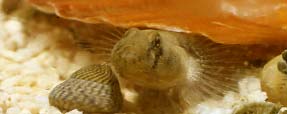
|
|
| Placozoa |
| Porifera |
| Cnidaria |
| Ctenophora |
| Mesozoa |
| Platyhelminthes |
| Nemertina |
| Gnathostomulida |
| Gastrotricha |
| Rotifera |
| Kinorhyncha |
| Loricifera |
| Acanthocephala |
| Entoprocta |
| Nematoda |
| Nematomorpha |
| Ectoprocta |
| Phoronida |
| Brachiopoda |
| Mollusca |
| Priapulida |
| Sipuncula |
| Echiura |
| Annelida |
| Tardigrada |
| Pentastoma |
| Onychophora |
| Arthropoda |
| Pogonophora |
| Echinodermata |
| Chaetognatha |
| Hemichordata |
| Chordata |
| TELEOSTEI |
|
|
 |
Common Name(s):
Common Goby Scientific Name: Pomatoschistus microps Family: Gobiidae Size: to 64 mm
|
| Identification:
Small goby (a family of small fishes with a notorious reputation of being difficult to differentiate, characterised by a pair of dorsal fins, and a pelvic fin fused into a weak suction cup). Sandy colour, but not so long as the similar species Pomatoschistus minutus. In breeding coloration the male fish has a dark blotch at the rear of the first dorsal fin. This blotch is not ringed with white (as a diagnostic feature on its own, this is bit of a dodgy characteristic). Only experienced rockpoolers are likely to be able to separate these species in the wild. The row of black dots are usually more distinct on this species rather than the similar species, but this cannot be relied on entirely for identification purposes, and this difference can only be distinguished in captivity, looking at the fish from the side, when in the wild all observations would be looking down on the fish resting on the sand. Photograph by Mike Noren (Link to) Similar Species:
Pomatoschistus
pictus Painted Goby. Note the two dark band on the dorsal fin.
Size about 2.5cm. Photographed at Tjärnö Aquarium by Mike Noren.
Breeding:
The larvae hatched from eggs in 11-14 days at 12-15° C (AH*). The male fish ate the fry in a few hours on all occasions (about 10). (*from memory)
Habitat: Sandy shallows, intertidal with shallow sandy pools, estuaries in summer. Food:
Range:
Additional Notes:
Gobies are difficult to identify. Photographs in books cannot be relied upon because the identifications of British species are wrong over 50% of the time. Differences between Blennies & Gobies Shorewatch Project EMail Glaucus@hotmail.com.
|
| FIVE KINGDOMS TAXONOMIC INDEX TO BRITISH MARINE WILDLIFE |
|
|
|
|
|
News 2001 |
Membership Form |
|
